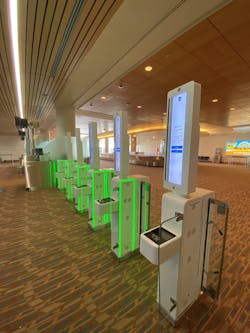Biometric and Contactless Technology will be Key to the Revival of International Tourism Industry, American Airport Managers Must Ensure They are Ready
A global economic crisis of this magnitude, causing such widespread, multi-sectored, cross-continental turmoil, has not been seen since 1932. COVID-19 has affected every country with their fair share of economic and health crises, a simultaneous attack across the world that has inflicted sustained damage for the short and long term.
Amongst the sectors hit hardest by the onset of the pandemic is the travel and tourism sector. Reports have indicated that the international tourism industry lost $320 billion in revenues in the first five months of the year as air travel and vacations ground to a halt. This is more than three times the loss experienced during the global economic crisis of 2008, predominantly as a result of the drastic decrease in the number of international tourist arrivals, which saw 300 million fewer people (56%) compared to the same period last year. World Travel and Tourism Council data estimates that 75 million travel and tourism jobs will be lost with a $2.1 trillion decrease in GDP across the globe.
With worldwide lockdowns beginning to ease, the aviation industry is being asked to implement new strategies and rules that require thoughtful and coordinated responses. With the element of consumer confidence very much in play, the aviation industry is trying to surpass challenges that they were largely unprepared for. This means airport and airline bosses proactively putting in place strategies that enable hygienic traveler clearance throughout their infrastructure that bring peace of mind to passengers while enhancing the airport experience.
This is not the first time in recent history that airports have had to drastically enhance their passenger safety infrastructure. The tragic events of September 11, 2001, in New York, Washington D.C., and Pennsylvania sent seismic shockwaves across the entire aviation industry, with security measures being entirely redesigned to become more thorough and to give travelers the confidence to return to the skies. With these changes came additional waiting times, initiating a research and development effort of faster identification technology that made traveler clearance more efficient, without compromising security or safety. Now, aviation stakeholders are again facing another traveler confidence crisis – the threat of pathogens and localized COVID-19 outbreaks.
Data provider Dynata and social research agency Blackbox Research recently conducted a study examining the feelings, preferences, and expectations of 10,195 people across 17 countries regarding travel in a post COVID-19 era. The study suggested that contactless travel will be a new benchmark expected by travelers, with 76% of respondents indicating that their preferred travel destinations would have airports offering reliable touchless identity and contactless clearance experiences.
The study also found that e-boarding passes (44%), touchless lavatories (43%), contactless journeys from airports to hotels (40%), empty middle seats in transportation (36%), and digital health passports (35%) are some of the new ideas global travelers hope to see implemented in the near future.
Results of the study strongly point towards passengers actively basing their travel choices on hygienic safety measures implemented at the airports – including biometric technology. While some of these strategies were being strongly looked at before the pandemic, Covid-19 has accelerated the need for implementing smart and safe contactless technologies, as new health regulations created an urgent need to safely manage large crowds. The demand is clear, the supply is key.
According to another recent high-profile industry survey conducted by Vision-Box of top airports, airlines, and government agencies released in June 2020, 63% of organizations in the aviation sector will seek to implement biometric technologies at airports using contactless travel.
Over 75% of the surveyed institutions reported having undertaken several changes, primarily to protect staff and to adjust schedules for better crowd control, with approximately a quarter of respondents (24%) using facial identification, with another 12% using fingerprints to enable safe contactless travel for passengers. Currently, 23% are using QR Codes, 15% are using RFID, while 9% do not use any of the technology.
The survey also found 63% of respondents are very interested in facial biometrics, making it by far the digital identification method companies and agencies are mostly interested in implementing. Mobile ID and wireless technology are also seen as additional positive technologies and considered as an alternative or supplement to biometrics. Of their main digital transformation priorities for the next 1-3 years, the highest number of respondents expressed an interest in touchless security and screening (26%), followed by passenger seamless flow management (24%), remote passenger registration/check-in (18%), and digital identity management platforms (13%).
Both the Vision-Box and Dynata/ Blackbox Research studies seem to indicate an industry wide trend and preference for seamless traveler identification systems. The industry seems to be leaning towards securing the traveler journey using automated biometric technology, particularly facial recognition, for safe, socially distanced travel experiences in a post COVID-19 environment.
The primary objective remains to manage crowds using safe, socially distant technology, and minimizing close human-to-human interaction.
Airports are likely most interested in these technologies because of the overall foot traffic that is likely to quickly to reach pre-pandemic levels and continue its increasing trend.
One thing is for certain – with the international transportation and tourism industry facing record losses, biometric AI technology for seamless travel could well prove to be the vaccine the sector so desperately needs.
Miguel Leitmann, CEO of Vision-Box

